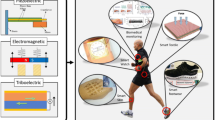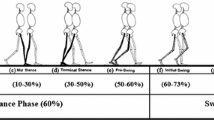Abstract
The use of piezo-resistive uni-axial accelerometer signals in gait analysis is complicated by the fact that the measured signal is composed of different types of acceleration. The aim of the study is to obtain insight into the signal from a tangential accelerometer attached to the thigh during walking. Six subjects walk with three different speeds. Simultaneous measurements are performed with accelerometers, footswitches and an opto-electronic system. The components of the accelerometer signal are calculated from the opto-electronic system. A clear relationship is found between the measured and calculated accelerometer signals (range RMS: 0.76–3.69 m s−2, range rms: 0.22–0.61). The most pronounced feature is a high positive acceleration peak (> 10 m.s−2) at the end of the cycle. The gravitational acceleration during one cycle is characterised by a sinusoidal shape, whereas the inertial acceleration contains higher-frequency components (up to 20 Hz). During the major part of the gait cycle, the gravitational and inertial acceleration make opposing contributions to the signal. As a result, the gravitational acceleration influences the amplitudes of the measured acceleration signal, the shape and peaks of which are mainly determined by the inertial acceleration. Because the gravitational and inertial accelerations differ in frequency components, the application for gait analysis remains feasible.
Similar content being viewed by others
References
Aminian, K., Rezakhanlou, K., de Andres, E., Fritsch, C., Leyvraz, P.-F., andRobert, P. (1999): ‘Temporal features estimation during walking using miniature accelerometers: an analysis of gait improvement after hip arthrosplasty’,Med. Biol. Eng. Comput.,37, pp. 686–691
Breniere, Y., andDietrich, G. (1992): ‘Heel-off perturbation during gait initiation: biomechanical analysis using triaxial accelerometry and a force plate’,J. Biomech.,25, pp. 121–127
Bussmann, J. B. J., Tulen, J. H. M., Herel van, E. C. G., andStam, H. J. (1998a): ‘Quantification of physical activities by means of accelerometry: a validation study’,Psychophysiol.,35, pp. 488–496
Bussmann, J. B. J., Laar van de, Y. M., Neeleman, M. P., andStam, H. J. (1998b): ‘Ambulatory accelerometry to quantify motor behavior in patients after failed back surgery”,Pain,74, pp. 153–161.
Bussmann, H. B. J., Reuvekamp, P. J., Veltink, P. H., Martens, W. L. T., andStam, H. J. (1998c): ‘Validity and reliability of measurements obtained with an ‘Activity Monitor’ in people with and without a transtibial amputation’,Phys. Ther.,78, pp. 989–998
Bussmann, J. B. J., andStam, H. J. (1988): “Techniques for measurement and assessment of mobility in rehabilitation medicine: a theoretical approach”,Clin. Rehabil.,12, pp. 455–464
Currie, G., Rafferty, D., Duncan, G., Bell, F., andEvans, A. L. (1992): ‘Measurement of gait by accelerometer and walkway: a comparison study’Med. Biol. Eng. Comp.,30, pp. 669–670
Davis, R. B. (1988): ‘Clinical gait analysis’,IEEE Eng. Med. Biol. Mag., pp. 35–40
Evans, A. L., Duncan, G., andGilchrist, W. (1991): ‘Recording accelerations in body movements’,Med. Biol. Eng. Comput.,29, pp. 102–104
Inman, V. T., Ralston, H. J., andTodd, F. (1994): ‘Human locomotion’, inRose, J., Ralston, H. J., andGamble, J. G. (Eds): ‘Human walking’ (Williams & Wilkins, Baltimore) pp. 1–22
Jaegers, S. M. H. J., Arendzen, J. H., andJongh de, H. J. (1995): ‘Prosthetic gait of unilateral transfemoral amputees: a kinematic study’,Arch. Phys. Med. Rehabil.,76, pp. 736–743
Lohman, A. H. M. (1990): ‘Vorm en beweging Leerboek van het bewegingsapparaat van de mens’ (in Dutch) (Bohn Scheltema & Holkema, Utrecht)
Moe-Nilssen, R., Ljunggren, A. E., andTorebjork, E. (1999): ‘Dynamic adjustments of walking behaviour dependent on noxious imput in experimental low back pain’,Pain,83, pp. 477–485
Murray, M. P., Drought, A. B., andKory, R. C. (1964): ‘Walking patterns of normal men’,J. Bone Joint Surg.,46-A, pp. 335–360
Murray, M. P. (1967): ‘Gait as a total pattern of movement’,Am. J. Phys. Med.,46, p. 210
Oberg, T., Karsznia, A., andOberg, K. (1993): ‘Basic gait parameters: reference data for normal subjects, 10–79 years of age’,J. Rehabil. Res. Devel.,30, pp. 210–223
Robinson, J. L., Smidt, G. L., andArora, J. S. (1977): ‘Accelerographic, temporal and distance gait factors in below-knee amputees’,Phys. Ther.,57, pp. 898–904
Saunders, J. B. D. M., Inman, V. T., andEberhart, H. D. (1953): ‘The major determinants in normal and pathological gait’,J. Bone Joint Surg.,4-A, pp. 543–558
Smidt, G. L., Arora, J. S., andJohnston, R. C. (1971): ‘Accelerographic analysis of several types of walking’,Am. J. Phys. Med.,50, p. 285
Smidt, G. L., Deusinger, R. H., Arora, J., andAlbright, J. P. (1977): ‘An automatic accelerometry system for gait analysis’,J. Biomech.,10, pp. 367–375
Spivack, B. S. (Ed.) (1995): ‘Evaluation and management of gait disorders’ (Marcel Dekker Inc., New York)
Sutherland, D. H., Kaufman, K. R., andMoitoza, J. R. (1994): ‘Kinematics of normal human walking’ inRose, J., Ralston, H. J., andGamble, J. G. (Eds): ‘Human walking’ (Williams & Wilkins, Baltimore), pp. 23–44
van Emmerik, R. E. A., andWagenaar, R. C. (1996): ‘Effects of walking velocity on relative phase dynamics in the trunk in human walking’,J. Biomech.,29, pp. 1175–1184
Veltink, P. H., Bussmann, H. B. J., Vries De, W., Martens, W. L. J., andvan Lummel, R. C. (1996): ‘Detection of static and dynamic activities using uniaxial accelerometers’,IEEE Rehabil. Eng.,4, pp. 375–385
Wagenaar, R. C., andBeek, W. J. (1992): ‘Hemiplegic gait: a kinematic analysis using walking speed as a basis’,J. Biomech.,25, pp. 1007–1115
Whittle, M. W. (1996): ‘Gait analysis; an introduction’ (Butterworth-Heineman, Oxford)
Willemsen, A. T., Bloemhof, F., andBoom, H. B. (1990): ‘Automatic stance-swing phase detection from acccelerometer data for peroneal nerve stimulation’,IEEE Trans.,BME-37, pp. 1201–1208
Winter, D. A. (1990): ‘Biomechanics and motor control of human movement’ (John Wiley & Sons, New York)
Wu, G. (1994): ‘A review of body segmental displacement, velocity, and acceleration in human gait’ inCraik, R. L., andOatis, C. A. (Eds): ‘Gait analysis, theory and application’ (Mosby, St. Louis), pp. 205–222
Author information
Authors and Affiliations
Corresponding author
Rights and permissions
About this article
Cite this article
Bussmann, J.B.J., Damen, L. & Stam, H.J. Analysis and decomposition of signals obtained by thigh-fixed uni-axial accelerometry during normal walking. Med. Biol. Eng. Comput. 38, 632–638 (2000). https://doi.org/10.1007/BF02344868
Received:
Accepted:
Issue Date:
DOI: https://doi.org/10.1007/BF02344868




